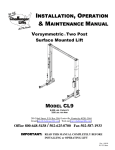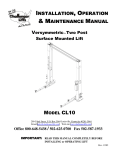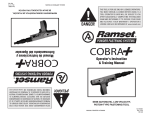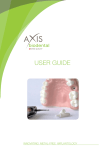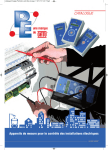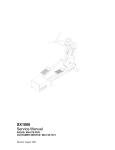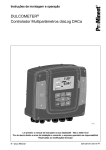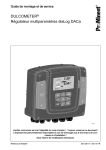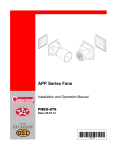Download RAMSET RT400 M Operating instructions
Transcript
DANGER THIS TOOL FOR USE BY LICENSED OPERATORS ONLY. READ AND OBEY ALL SAFETY AND OPERATING INSTRUCTIONS BEFORE OPERATING TOOL. RAMSET RT400 (M) TOOL OPERATOR’S SAFETY & OPERATING INSTRUCTION MANUAL SEMI-AUTOMATIC, LOW VELOCITY PISTON TYPE FASTENING TOOL SAFETY INTRODUCTION DANGER DANGER THIS TOOL IS TO BE USED ONLY BY PROPERLY TRAINED AND LICENSED OPERATORS. YOU MUST SUCCESSFULLY COMPLETE THE ITW RAMSET/RED HEAD’S TRAINING PROGRAM FOR THE TOOL AND OBTAIN A CERTIFIED OPERATOR’S LICENSE BEFORE HANDLING, LOADING OR OPERATING THIS TOOL. ATTEMPTING TO HANDLE OR OPERATE THIS TOOL WITHOUT PROPER TRAINING AND LICENSING CAN RESULT IN SERIOUS INJURY TO THE OPERATOR OR BYSTANDERS. Operator’s and bystanders must wear eye and hearing protection. Read manual before operating tool. Never close tool with hand over fastener loading end of the tool. A serious hand injury from penetration by the piston or a discharged fastener could result. DANGER Just as no one can merely read a book about driving an automobile and then hope to drive one safely, no one should attempt to use any Ramset tool without adequate, competent personal instruction. And just as one must be licensed to drive an automobile, one must also be licensed to use a powder actuated tool. No automobile instruction book or instructor can forewarn a learner against all possibilities and emergencies, nor can ITW Ramset/Red Head instructors and printed material detail all possible conditions surrounding the use of ITW Ramset/Red Head tools and products. Responsibility for the safe and proper use of this tool rests with the tool user and the employer. SAFETY INTRODUCTION 2 DANGER DANGER SAFETY INSTRUCTIONS Preparation Acceptable Base Materials Powder actuated fastening is suitable for use in the following base materials only: • Poured Concrete • Structural Steel • Masonry Joints (see page 8) Never attempt to fasten into any other type of material. Fastening into other materials can cause blindness or other serious injury. NEVER FASTEN INTO VERY HARD OR BRITTLE MATERIALS Unacceptable Base Materials Never attempt to fasten into very hard or brittle materials such as cast iron, tile, glass, or rock of any type. These materials can shatter, causing the fastener and/or base material fragments to fly free and cause serious injury to the tool operator and others. Never fasten into soft base materials, such as drywall or lumber products. These materials may allow the fastener to travel completely through and out the other side, endangering those in the path of the fastener. Never fasten into any base material that does not pass the Center Punch test. Failure to assure the suitability of the base material can result in serious injury to the eyes or other body parts. Center Punch Test ALWAYS WEAR SAFETY GOGGLES WHEN PERFORMING THIS TEST. 1. Always check the material being fastened into for hardness before attempting any fastening operation. NEVER FASTEN INTO SOFT MATERIALS SUCH AS DRYWALL Center Punch Test Results 1. If the fastener point is flattened, the material is too hard for a powder actuated fastening. 2. If the fastener penetrates the material easily, the material is too soft. 3. If the material cracks or shatters, the material is too brittle. 4. If the fastener makes a small indentation into the material, the material is suitable for fastening. 2. Using a fastener as a center punch, strike the fastener against the work surface using an average hammer blow and check the results. DANGER SAFETY INSTRUCTIONS 3 DANGER SAFETY INSTRUCTIONS Loads & Load Selection Safety 1. Always make a test fastening after being sure that the base material is suitable for powder actuated fastening. Failure to determine the correct power level to be used may result in the use of excessive power, allowing the fastener to pass completely through the work material, causing serious or fatal injuries to others who may be in the path of the fastener. ALWAYS MAKE A TEST FASTENING 2. Color-blind operators must always select strip loads by number to prevent use of an incorrect load for the same reasons as in #1 above. Workplace Safety 1. Operators and bystanders must always wear approved safety goggles and approved hearing protection. Failure to do so may result in blindness or serious eye injury from flying debris and loss of hearing from constant or repeated unprotected exposure to fastening noise. 2. Always keep the work area clear of bystanders and unnecessary materials that could interfere with safe tool operation. Operating the tool in a congested or cluttered area may affect your ability to operate the tool safely. 3. Never operate tool if flammable or explosive materials are nearby. Powder loads burn and create sparks when fired and could ignite these materials or fumes. 4. Always post warning signs within 50 ft. of the area where fastening is to be done. Sign must state: “Caution - Powder Actuated Tool In Use”. Failure to warn others may result in serious injury to them. Contact ITW Ramset/Red Head at 1-800-348-3231 to obtain this sign. SAFETY INSTRUCTIONS 4 COLOR-BLIND OPERATORS MUST ALWAYS SELECT LOADS BY NUMBER KEEP WORK AREA CLEAR OF BYSTANDERS AND CLUTTER NEVER OPERATE THE TOOL AROUND FLAMMABLE OR EXPLOSIVE MATERIALS Concrete Fastening Systems POWDER ACTUATED TOOL IN USE WITHIN 50 FEET BY PROPER CAUTION, SAFETY IS ASSURED ALWAYS POST WARNING SIGNS DANGER DANGER SAFETY INSTRUCTIONS Tool Handling Safety 1. Always be sure tool is operating properly before attempting to use it. Follow the “Daily Function Check” shown to the right and described on page 9. 2. Always load tool using a strip load selected directly from a box indicating the power load type and number. Never attempt to use loose strip loads that could be mis-identified. 3. Never carry loose strip loads in pockets with pins or other hard objects. Empty A B C D ALWAYS DO A DAILY FUNCTION CHECK BEFORE LOADING TOOL 4. Never load a tool unless you intend to immediately make a fastening. Loading a tool and leaving it unattended in the work area can result in the tool being accidentally discharged by others. 5. Never place your hand or any other body part over the fastener loading end of the tool. Serious hand injury could result from being struck by either a fastener or the tool piston should the tool be accidentally fired. NEVER LOAD THE TOOL UNLESS IT IS TO BE USED IMMEDIATELY 6. Always store the tool unloaded and keep the tool and the loads securely locked in a tool box. Keep keys away from children and unlicensed persons. 7. Always keep the tool pointed away from yourself and others. 8. Never carry a loaded tool around the work area. NEVER PLACE HANDS OR BODY OVER MUZZLE OPENING 9. Never allow anyone not trained to use the tool. 10. Never engage in horseplay with the tool. 11. Using the tool in poorly ventilated areas, cleaning tool or handling loads may result in exposure to lead or other substances known to cause birth defects, and other physical harm. Have adequate ventilation at all times and wash thoroughly after exposure. DANGER KEEP TOOL LOCKED & OUT OF THE REACH OF CHILDREN SAFETY INSTRUCTIONS 5 DANGER SAFETY INSTRUCTIONS FAILURE TO FOLLOW INSTRUCTIONS CAN CAUSE INJURY TO THE TOOL OPERATOR OR TO BYSTANDERS. Fastener Driving Safety 1. Only use the tool for fastening into a suitable base material. 90° ALWAYS HOLD THE TOOL PERPENDICULAR TO THE WORK SURFACE 2. Never fire the tool without a fastener. Firing a tool without a fastener will cause the piston to strike the work surface, and may cause serious injury to you and others in the work area. 3. Always hold the tool perpendicular to and firmly against the work surface when making a fastening. Failure to do so could allow a fastener to ricochet. 4. Never attempt to drive a fastener close to an edge or to another fastener. See page 8 for guidelines. ALWAYS FOLLOW THE MISFIRE PROCEDURE. If the tool does not fire after pulling the trigger, continue to hold the depressed tool against the work surface for at least 30 seconds. Then carefully open the tool, remove the load strip, and put it in a can of water or other non-flammable liquid. Never carelessly discard a strip with live loads into a trash container. NEVER DRIVE A FASTENER CLOSE TO AN EDGE 30 HOLD THE TOOL FIRMLY AGAINST THE WORK SURFACE FOR AT LEAST 30 SECONDS If the tool becomes stuck or jammed with a live powder load, keep the tool pointed in a safe direction, and immediately tag it, “Danger- defective - do not use”. Lock the tool in a tool box and call your local Ramset distributor for assistance. SAFETY INSTRUCTIONS 6 DANGER FASTENERS / LOADS Your Ramset RT400 Tool uses only the Ramset fasteners and loads shown below or listed for the tool in the Product Catalog. DANGER Never use any other types of fasteners or strip loads in the Ramset RT400 Tool. Use of other types of fasteners or loads may cause unintentional load discharge, damage the tool, cause poor fastening performance, or create a risk of serious injury to the operator or bystanders. FASTENERS .300 HEAD PLASTIC FLUTED DRIVE PINS .300 HEAD PLASTIC FLUTED DRIVE PINS WITH 7/8" WASHER .145 Shank Diameter in Shank Lengths from 1/2" to 1-1/2" 1/4" - 20 THREADED STUDS .145 Shank Diameter in Shank Lengths of 1/2" and 1" and Thread Lengths of 1/2", 3/4" and 1" 8 mm HEAD TOP-HAT DRIVE PINS .145 Shank Diameter in Shank Lengths from 1/2" to 1" .145 Shank Diameter in Shank Lengths from 1" to 2" .300 HEAD POWER POINT PLASTIC FLUTED DRIVE PINS .150 Straight Shank in Shank Lengths from 1/2" to 7/8" .150 /.180 Step Shank in Lengths from 1" to 1-1/4" CEILING CLIP ASSEMBLIES CONDUIT CLIP ASSEMBLIES For 1/2" and 3/4" Diameter Conduit with 7/8" Premounted Fastener Ceiling Clip with 1" or 1-1/4" premounted .145 Shank Pin and Ceiling Clip with 1" or 1-1/4" Premounted .150/.180 Shank Pin LOADS Ramset RS27 strip loads are specially made for use in the Ramset RT400 Tool. RS27 10 SHOT STRIP LOAD POWER CATALOG LEVEL NUMBER 2 2RS27 3 3RS27 4 4RS27 5 5RS27 LOAD COLOR Brown Green Yellow Red CASE COLOR Brass Brass Brass Brass The power level of the load is indicated by the number marked on each box, the color of the box, and the color on the tip of each load. As the number increases, the power level also increases. Always perform the center punch test described on page 3 to test the base material. Always make a test fastening using the lowest power level first. If more power is required to set the fastener, use the next higher power level until the powder level necessary to drive the fastener is reached. FASTENERS / LOADS 7 FASTENING APPLICATIONS FASTENING APPLICATIONS Your Ramset tool can be used for a wide range of fastening needs in a variety of base materials.Reading and follow these important fastening guidelines will help you get the best results from your tool, fasteners, and powder loads, as well as help you perform these fastening operations safely and effectively. 3" MIN. 3" MIN. SPACING WOOD TO CONCRETE Powder actuated fastenings are permanent fastening so attempting to remove a fastener from concrete or steel may result in serious injury. 3" MIN. Fastening to Concrete When fastening into concrete, always maintain a minimum spacing of 3" between fastenings and 3" from any free edge. Concrete thickness should be at least three times the intended penetration depth into the concrete. The primary exception to the 3" edge distance can occur in a sill plate application where, by necessity, the edge distance is reduced. Driving fasteners too close to an edge or too close to each other can cause the concrete edge to fail or fasteners to fly free. PENETRATION — THIN GAUGE METAL TO CONCRETE 3" MIN. Fastening to Concrete Block or to Masonry Walls While this application is not recommended, when used, it is necessary to take care to observe a 3" edge distance to avoid cracking the block and over penetration of the fastener to avoid loss of holding value. Fastening may be made into the horizontal joint but not into the vertical joint. SPACING — FURRING STRIP TO CONCRETE 1/2" MIN. 1-1/2" MIN. Fastening to Steel Your Ramset tool can be used for fastening on the flat surfaces of structural steel. When fastening into steel, always maintain a minimum spacing of 1-1/2" between fastenings and 1/2" from any edge. FASTENING APPLICATIONS 8 SPACING — STEEL TO STEEL TOOL OPERATING INSTRUCTIONS TOOL OPERATION Daily Function Test Always check the tool first to make sure that it does not contain a strip load or fastener. Test the tool several times by depressing the muzzle bushing fully on a hard surface and pulling the trigger. You should hear an audible click as the firing pin releases. Let up on the tool and check to be sure that the barrel has opened to the full open position. PERFORM FUNCTION TEST WITH EMPTY, UNLOADED TOOL OPERATING THE RAMSET RT400 TOOL 1. After checking to be sure that the tool is not loaded, point it in a safe direction and be sure that the barrel is fully extended. This assures that the piston is in position for the next fastening. BE SURE BARREL IS FULLY FORWARD 2. With finger off the trigger, place the fastener, point out, into the muzzle end of the tool until the point end is inside the muzzle. NEVER load a fastener with your finger on the trigger. DO NOT use excessive force when inserting a fastener. STOP immediately if excessive force is require, inspect the barrel to find out why the fastener is not entering the muzzle freely. DO NOT continue loading unless the problem is corrected. INSERT FASTENER INTO THE MUZZLE END OF THE TOOL WITH THE POINT OUT 3. With the tool pointed in a safe direction and finger away from the trigger, insert a load strip into the bottom of the handle and push it in until bottom of the strip is equal to the bottom of handle. INSERT LOAD STRIP INTO THE SLOTS IN THE RECEIVER HOUSING TOOL OPERATING INSTRUCTIONS 9 TOOL OPERATING INSTRUCTIONS 4. Hold the tool perpendicular (90°) to the work surface with both hands and press firmly to fully depress the tool. Maintain firm downward pressure on the tool with both hands and pull the trigger to drive the fastener. DO NOT DEPRESS THE TOOL AGAINST ANYTHING OTHER THAN THE INTENDED WORK SURFACE. Holding the tool firmly in place will produce more consistent fastening quality and minimize tool wear or damage. 5. After making the fastening, let up on the tool pressure and note that the barrel assembly returns to the full open position. This automatically resets the piston for the next fastening. Always keep fingers and other body parts away from the muzzle end of the tool. 90° HOLD THE TOOL FIRMLY AND PERPENDICULAR TO THE WORK SURFACE LET UP ON TOOL PRESSURE. NOTE THE BARREL HAS RETURNED TO THE OPEN POSITION 6. Insert another fastener in the muzzle end of the tool as before and the tool is ready for the next fastening. Keep your finger off of the trigger until the tool is in position to drive the fastener. 7. To remove a used or partially used strip load from the tool, pull the strip out from the top of the tool. NEVER try to remove a jammed or stuck load strip. Should a “jammed” load strip occur, call your local Authorized Ramset Distributor for technical assistance. INSERT THE NEXT FASTENER REMOVE THE LOAD STRIP POWER LEVEL ADJUSTMENT The power of the tool may be adjusted for varying materials by turning the power adjust wheel. + INCREASE - DECREASE POWER LEVEL ADJUSTMENT TOOL OPERATING INSTRUCTIONS 10 TROUBLESHOOTING REFER TO PARTS SCHEMATIC FOR PROPER ASSEMBLY OF PARTS – Overdriving of fasteners – Tool fails to fire – Tool does not completely depress – Excessive power – Change to the next lower power level load strip color and number. Reduce power by turning the power adjustment wheel. – Soft base material – Check base material (see page 3) – Failure to depress completely – See “Tool does not completely depress” – Excessive dirt buildup on breech face not allowing proper penetration of firing pin – After following misfire procedure, check firing pin indentation on load. Clean breech face – Firing pin and/or breech damaged – Replace damaged parts – Misassembled or damaged parts – Check all parts in the receiver for damage or improper assembly. – Reduction or loss of power – Piston not being returned to the full rear position – Check to be sure that the return spring has pulled the barrel completely open to properly position the piston. – Worn or damaged retention – Replace missing worn or balls or clip on the buffer damaged parts assembly – Tool cannot be cocked or opened – Failure to index strip – Worn or broken pawls – Replace pawls – Excessive dirt buildup – Clean tool thoroughly – Damaged or bent piston – Replace piston – Broken or damaged parts – Tag tool with warning “Defective–Do Not Use” Place in a locked container and contact your local ITW Ramset/Red Head representative for service. – Strip not inserted in tool correctly or is damaged – Check load strip. Properly dispose of damaged strip. (See page 6) – Damaged indexing mechanism – Contact your ITW Ramset/ Red Head Distributor for assistance TROUBLESHOOTING 11 PARTS SCHEMATIC For Magazine Schematic and Parts Lists see page 14 PARTS SCHEMATIC 12 PARTS LIST RAMSET RT400 TOOL PARTS LIST KEY PART NO. DESCRIPTION QTY 1 2 3 4 5 6 7 8 9 10 11 12 13 14 15 16 17 18 19 20 21 22 23 24 25 26 27 28 29 30 31 32 A1000-4 A1001-7 A1000-11 A1001-1 A1001-2 A1001-3 A1001-4 A1001-5 A1000-6 A1099 A1001-8 A1067 A1063 A1068 A1045 A1094 A1095 A1089 A1088 A1069 A1100 A1060 A1074 A1061 A1075 A1046 A1005 316540 A1006 A1010 A1009 A1071 MAGAZINE ASSEMBLY MUZZLE BUSHING ASSEMBLY TRIGGER ASSEMBLY FIRING PIN ASSEMBLY ADVANCE LEVER ASSEMBLY POWER ADJUSTMENT ASSEMBLY END CAP ASSEMBLY HOUSING ASSEMBLY RECEIVER ASSEMBLY BUFFER ASSEMBLY, (pkg of 3) RETENTION COLLAR ASSEMBLY FIRING PIN SPRING ADVANCE LINK ASSEMBLY ADVANCE LEVER ASSEMBLY PIN ADVANCE LEVER ASSEMBLY RETENTION NUT MECHANISM HOUSING MECHANISM HOUSING PLUG COCKING ROD ROTARY SEAR COCKING ROD SPRING END CAP SCREW/WASHER PACKAGE TRIGGER MECHANISM PIN TRIGGER SPRING PLASTITE SCREW, TRIGGER TRIGGER SEAR SPRING HANDLE PAWL HOUSING PAWL, (pkg of 2) BARREL PISTON RETURN SPRING ROLL PIN 1 1 1 1 1 1 1 1 1 1 1 1 1 1 1 1 1 1 1 1 2 1 1 1 1 1 1 2 1 1 1 1 PARTS LIST 13 MAGAZINE SCHEMATIC / MAINTENANCE RT400 TOOL MAGAZINE SCHEMATIC AND PARTS LIST KEY PART NO. DESCRIPTION 1M A1011A MUZZLE ASSEMBLY 2M A1077A LOCKOUT ASSEMBLY 3M A1013 MAGAZINE HOUSING 4M A1021A SPRING BLOCK ASSEMBLY 5M A1014A MAGAZINE SLIDER/ FOLLOWER ASSEMBLY MAINTENANCE IMPROPERLY MAINTAINED TOOLS CAN CAUSE SERIOUS INJURIES TO TOOL OPERATOR AND BYSTANDERS CLEAN TOOL DAILY Always make sure the tool is not loaded before performing any service or repair and always wear safety goggles when cleaning or servicing the tool. NORMAL CLEANING All front end parts shown in the disassembly section are to be cleaned daily with a good detergent oil and wire brush. Remove all dirt and carbon buildup and wipe parts dry with a clean rag. Check all parts for wear or damage before reassembly and replace or repair any worn or damaged parts. COMPLETE CLEANING / GENERAL MAINTENANCE Heavy or constant exposure to dirt and debris may require that the tool be cleaned more extensively. Complete disassembly and cleaning of all parts may be necessary to restore the tool to normal operation. General maintenance should be performed every six months or more often if the tool is subjected to heavy use. Contact your authorized Ramset Distributor for assistance. ALWAYS FUNCTION TEST THE TOOL AFTER PERFORMING ANY SERVICE. SEE PAGE 9 FOR DETAILS ON THE FUNCTION TEST. MAGAZINE SCHEMATIC / MAINTENANCE 14 DISASSEMBLY TOOL DISASSEMBLY 1. Unscrew the barrel retention sleeve and slide it away from the tool housing. Handle the tool carefully after the sleeve is unscrewed to prevent the two barrel pawls from falling out. UNSCREW THE BARREL RETAINING SLEEVE 2. Remove the two pawls from the slots in the sides of the tool housing while holding the retention sleeve forward toward the muzzle end of the tool. REMOVE BOTH PAWLS 3. Slide the barrel assembly out of the tool body. Note the position of the slots on the side of the barrel and the rod at the lower rear of the barrel. Also note the position of the power adjust hole. SLIDE BARREL ASSEMBLY OUT OF THE TOOL BODY 4. Remove the retaining sleeve. REMOVE THE RETAINING SLEEVE 5. Remove the return spring. REMOVE THE RETURN SPRING DISASSEMBLY 15 DISASSEMBLY 6. Unscrew the muzzle bushing assembly which includes the plastic outer sleeve. Note: If this is difficult to do by hand, grasp the barrel under the plastic sleeve and use a wrench on the flats on the muzzle bushing to loosen the entire muzzle bushing assembly. 7. Remove the piston and the buffer assembly from the barrel. HOLD BARREL AND USE A WRENCH TO LOOSEN THE MUZZLE BUSHING ASSEMBLY 8. Inspect all parts for wear or damage and clean or replace as required. Use detergent oil and cleaning brush. Wipe parts dry before reassembly. WEAR SAFETY GOGGLES WHEN CLEANING TOOL PARTS. 9. Check the piston tip for mushrooming or other deformities, and grind flat. The tip of the piston must be 90° to the shank and grinding must only be done by qualified personnel. The overall minimum length of the piston must not be less than 6-1/8". When less than this length, the piston must be replaced to avoid tool damage. 10. Reassemble the tool in the reverse order of disassembly. ALWAYS PERFORM THE DAILY FUNCTION TEST BEFORE USING THE TOOL AFTER CLEANING OR SERVICING. DISASSEMBLY 16 PULL PISTON OUT OF THE MUZZLE BUSHING 18° 5/16" 90° GRIND PISTON TIP FLAT AND BEVEL THE TIP EDGE AT 18° MAGAZINE ASSEMBLY The Ramset RT400 magazine features a unique slip-clutch mechanism allowing the user to position the magazine at any angle. To Adjust The Magazine Angle: Rotate the magazine to the desired position. To Remove/Install the Magazine: 1. Be sure the tool is unloaded and remove any remaining fasteners from the magazine. TO ADJUST POSITION — ROTATE IN EITHER DIRECTION 2. Unscrew the barrel retention sleeve, remove the pawls, slide out the barrel assembly and remove the spring. These steps are further detailed on page 15. 3. Rotate the barrel and magazine so the square holes in the side of the magazine line up with the slots in the magazine collar. 4. Place the pawls into the square holes in the magazine. With the fastening end of the barrel pointed away from you, turn the barrel counter-clockwise to remove it from the magazine assembly. SLIDE BARREL ASSEMBLY OUT OF THE TOOL BODY 5. The magazine can be installed by following the reverse of the steps shown above. GRASP ASSEMBLY AROUND PAWLS TO SCREW ON MAGAZINE RT400 WITH MAGAZINE ATTACHED MAGAZINE ASSEMBLY 17 WARRANTY ALL WARRANTIES OF THE PRODUCTS DESCRIBED HEREIN, EXPRESSED OR IMPLIED, INCLUDING THE WARRANTY OF MERCHANTABILITY AND FITNESS FOR PARTICULAR PURPOSES, ARE SPECIFICALLY EXCLUDED, EXCEPT FOR THE FOLLOWING: Ramset will repair or replace, at its sole option, any tool, part, or fastener which, within 5 years after sale by Ramset is found by Ramset to be defective in material or workmanship, normal wear and tear excluded. THIS IS THE SOLE WARRANTY OF RAMSET AND THE SOLE REMEDY AVAILABLE TO THE BUYER AND IN NO EVENT WILL ANY DIRECT OR INDIRECT INCIDENTAL OR CONSEQUENTIAL DAMAGES, OR ANY OTHER DAMAGES, BE AVAILABLE. Copyright 2005 ITW Ramset/Red Head TM POWDER ACTUATED TOOL MANUFACTURES' INSTITUTE INC. THE MODEL RT400 TOOL COMPLIES WITH OSHA REQUIREMENTS AND WITH ANSI A10.3 SPECIFICATIONS FOR TOOL REPAIR SERVICE CONTACT YOUR LOCAL AUTHORIZED ITW RAMSET/RED HEAD DISTRIBUTOR OR CONTACT YOUR NEAREST RAMSET TOOL REPAIR CENTER WEST Los Angeles, CA MIDWEST Paris, KY EAST Allentown, PA 5950 Boxford Commerce, CA 90040 Phone: 800-368-9724 (CA only) Phone: 800-227-1823 Fax: 800-253-6444 7000 Bypass Road Paris, KY 40361 Phone: 800-816-6645 Fax: 800-816-6673 739 Roble Road Allentown,PA 18109 Phone: 800-266-9723 Fax: 610-266-0962 Concrete Fastening Systems Wood Dale, IL 60191 630-350-0370 www.ramset-redhead.com Buy with Confidence... Buy From Your Authorized Distributor © ILLINOIS TOOL WORKS 2005 PRINTED IN THE U.S.A. REVISED 01/05 Form No. SMRT400A-01/05





















